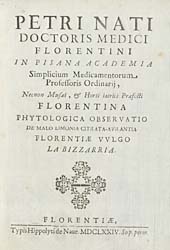The Bizzarria of Florence
Copyright © 2015 by Christ EDV Service | All Rights reserved | E-Mail: bm@zitrus.info

A detailed description of these extraordinary citrus plants was published by Pietro Nati in Florence in 1674. At this time Nati was the prefect of the Botanical Garden of the university Pisa. In his work Florentina phytologica observatio de malo limonia citrata-aurantia, Florentiae vulgo La Bizzarria he reported about a citrus tree, which should have originated about in 1644 on an estate close to Florence, including parts of citron, parts of sour orange and mixed parts of both citrus species.
Recognizing the special features of that tree - in particular the extraordinary and strange fruits - the gardeners reproduced and propagated the plant. Nati wrote in his study, starting from Tuscany the so-called 'La Bizzarria' had spread “almost all over the world”.
Today all of the Bizzarrias in plant collections and botanical gardens are probably progenies of the plant described by Pietro Nati.
Recognizing the special features of that tree - in particular the extraordinary and strange fruits - the gardeners reproduced and propagated the plant. Nati wrote in his study, starting from Tuscany the so-called 'La Bizzarria' had spread “almost all over the world”.
Today all of the Bizzarrias in plant collections and botanical gardens are probably progenies of the plant described by Pietro Nati.
Nevertheless, there are also historical accounts of other citrus Bizzarrias, already existing before 1644 as well as on those which cannot be progenies of the Bizzarria of Florence. However, these plants had only regional significance and were not propagated.
In 1589 the Italian polymath Giambattista della Porta reported in his Magiae naturalis about “a sour orange tree with half sour and half sweet fruits” on a shoot. He gave details about its origin as a bud failing. In 1646 Giovanni Battista Ferrari da Siena described and showed an engraving of a mixed fruit, which he received from Napoli. He called it Aurantium callosum multiforme.
Some other historical records about Bizzarrias with intermediate parts of other citrus species came from Egypt (Renouard, 1841), from USA (Uphof, 1935), Italy (Savastano and Parrozzani, 1911) and Japan (Takahasi, 1962).
Already Pietro Nati recognized the difficulty to explain the origin of the Bizzarria more exactly. He declared the natural origin of the Bizzarria - probably arisen by bud failing at the union where a citron bud had been inserted on a sour orange seedling.
However, many later gardeners and botanists did not believe that such a plant could have originated without human intervention. Different observers interpreted the constitution of the Bizzarria as a case of vegetative segregation from a seed hybrid or as a graft hybrid.
Only at the beginning of the 20th century the Bizzarrias were classified as synthetic chimeras confirming Natis description of the origin of the Florentine Bizzarria.
In 1589 the Italian polymath Giambattista della Porta reported in his Magiae naturalis about “a sour orange tree with half sour and half sweet fruits” on a shoot. He gave details about its origin as a bud failing. In 1646 Giovanni Battista Ferrari da Siena described and showed an engraving of a mixed fruit, which he received from Napoli. He called it Aurantium callosum multiforme.
Some other historical records about Bizzarrias with intermediate parts of other citrus species came from Egypt (Renouard, 1841), from USA (Uphof, 1935), Italy (Savastano and Parrozzani, 1911) and Japan (Takahasi, 1962).
Already Pietro Nati recognized the difficulty to explain the origin of the Bizzarria more exactly. He declared the natural origin of the Bizzarria - probably arisen by bud failing at the union where a citron bud had been inserted on a sour orange seedling.
However, many later gardeners and botanists did not believe that such a plant could have originated without human intervention. Different observers interpreted the constitution of the Bizzarria as a case of vegetative segregation from a seed hybrid or as a graft hybrid.
Only at the beginning of the 20th century the Bizzarrias were classified as synthetic chimeras confirming Natis description of the origin of the Florentine Bizzarria.